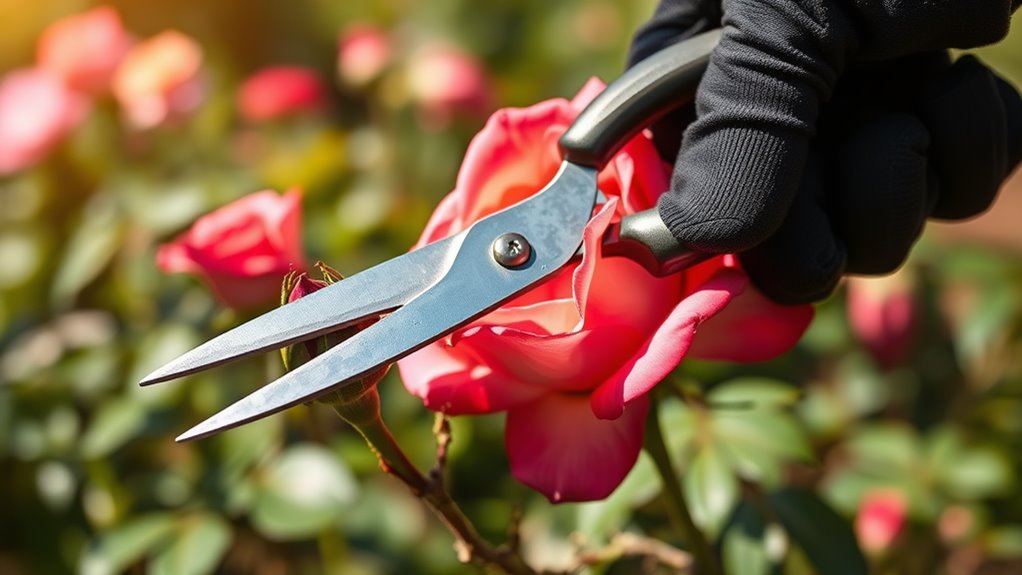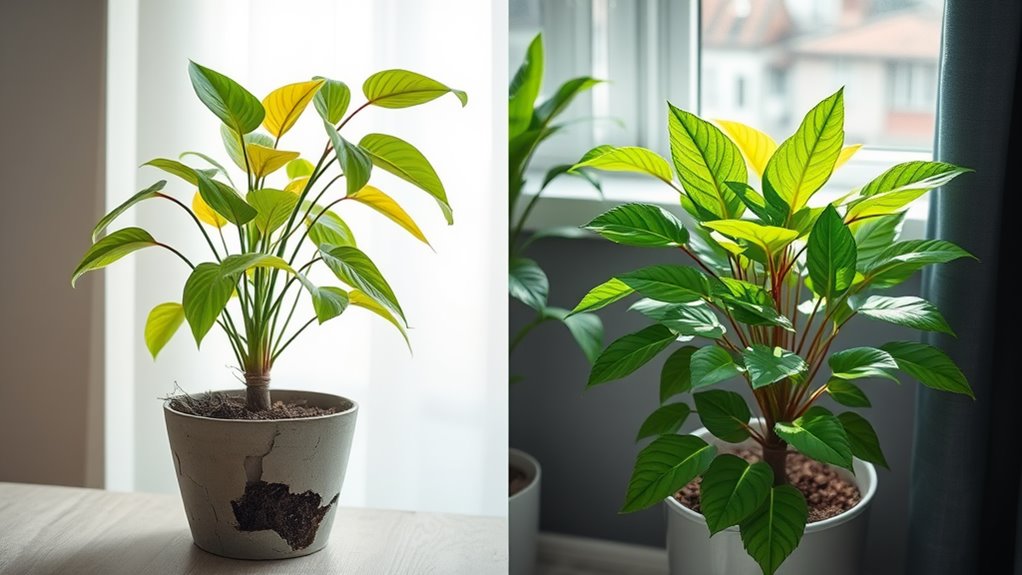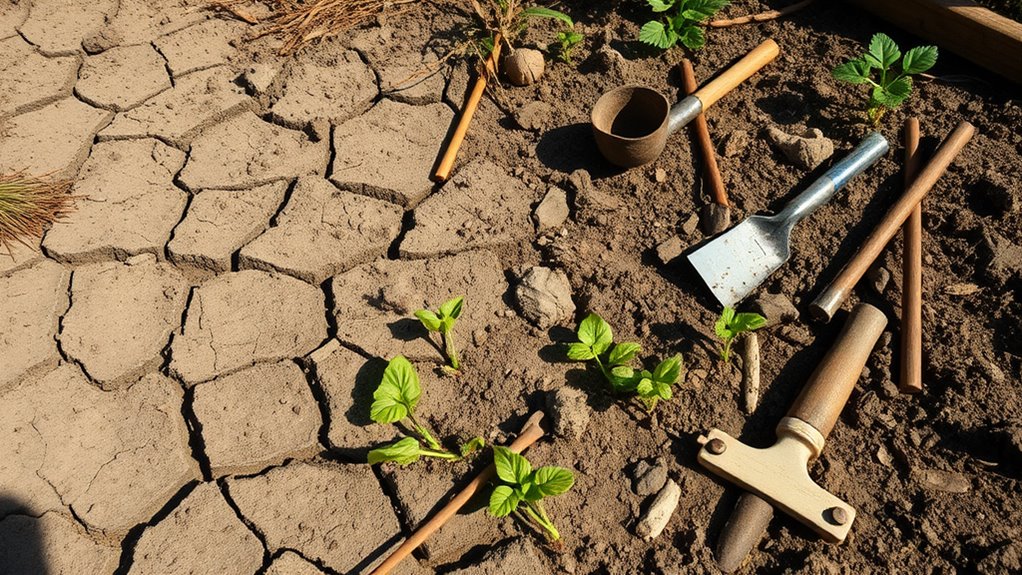The One Gardening Tool You’re Probably Using Wrong
You’re probably mishandling your pruning shears, the most common gardening tool that can damage plants with blunt blades or poor technique. Gripping too tightly causes hand fatigue, while abrupt motions risk injury and messy cuts. Choose comfortable shears with sharp edges, sharpen and oil them regularly, and maintain good posture for efficient use. Fix these habits to promote plant health and safety—you’ll discover advanced strategies to boost your gardening results.
Key Takeaways
- Pruning shears are commonly misused with dull blades, causing torn cuts that harm plants instead of promoting healing.
- Grip pruning shears lightly and comfortably to maintain control, reducing hand fatigue and preventing accidents.
- Always select the right size and type of pruning shears for your plants to avoid damage from improper tool use.
- Regularly sharpen and oil pruning shears after use to ensure clean cuts and extend tool longevity.
- Maintain proper posture and technique when using pruning shears to minimize strain and improve gardening efficiency.
The Most Common Misused Gardening Tool
When you’re gardening, pruning shears top the list as the most commonly misused tool, often leading to damaged plants if not handled correctly.
As essential gardening tools, they require sharp blades and proper technique to avoid harm. You must select shears that fit your hand comfortably, ensuring clean cuts that promote healing. Moreover, correct usage can greatly enhance garden efficiency.
Regularly sharpen and oil them to maintain effectiveness, preventing tears in stems or branches.
By following a straightforward methodology for pruning, gardeners can enhance their skills and achieve better results.
Identifying Common Errors in Usage
When you’re using gardening tools, you often encounter common usage errors that can damage your equipment or plants.
Watch out for typical handling blunders, like gripping tools too tightly or ignoring maintenance needs.
Recognizing these mistakes helps you work more effectively and extend your tools’ lifespan.
For instance, familiarizing yourself with the top five must-have gardening tools can help prevent many of these errors.
For optimal performance, incorporate essential maintenance tips to prepare your tools for the growing season.
Common Usage Errors
Even though gardening tools are straightforward, you’ll frequently make common usage errors that can shorten their lifespan or lead to accidents. For example, you might select the wrong tool for a task, like using a trowel on hard clay, or ignore proper maintenance, such as not wiping tools clean after use. These mistakes reduce efficiency and increase risks.
| Common Error | Description | Consequence |
|---|---|---|
| Wrong tool choice | Using a tool for unsuitable tasks | Faster wear and tear |
| Poor maintenance | Neglecting cleaning or checks | Reduced performance |
| Inadequate storage | Leaving tools exposed to elements | Rust and structural damage |
Typical Handling Blunders
Beyond common usage errors, you often mishandle gardening tools in ways that lead to blunders like improper gripping or abrupt motions, which can cause injuries or damage.
These mistakes compromise safety and efficiency, so let’s address them directly.
-
You grip the tool too tightly, leading to hand fatigue and reduced control, making tasks harder and increasing slip risks.
-
You use abrupt motions instead of smooth ones, causing strain on your joints and potential tool breakage during use.
-
You neglect proper posture while handling, putting unnecessary pressure on your back and heightening the chance of long-term injury.
-
You skip routine checks for wear, resulting in unstable handles that could lead to accidents or ineffective gardening.
Mastering the Proper Technique
To master proper technique with your gardening tools, you’ll start by nailing grip basics for a secure hold. For better outcomes, evaluate smart gardening tools based on their exceptional value.
Next, focus on stance essentials to maintain balance and control during tasks.
Finally, apply motion corrections to ensure smooth, efficient movements that boost your overall performance.
Additionally, integrating essential gear can simplify the planting process and engage beginners.
Grip Basics
Mastering a proper grip on your gardening tools is key to safe and efficient work. When you grip correctly, you reduce injury risks like blisters or slips, enhance control, and make tasks easier on your hands.
This simple adjustment boosts your overall gardening performance without unnecessary strain.
Here are four essential tips to master your grip:
-
Wrap your fingers fully around the handle for a secure, even hold that prevents slipping during use.
-
Position your thumb opposite your fingers to create leverage and stability, especially on heavier tools.
-
Keep your grip relaxed yet firm to avoid fatigue, allowing you to work longer with precision.
-
Test and adjust your hold based on tool size, ensuring comfort and effectiveness for each job.
Stance Essentials
A proper stance is crucial for safe and effective gardening, as it helps you maintain balance, reduce strain, and prevent injuries while handling tools.
Position your feet shoulder-width apart for a stable base, with one foot slightly forward to enhance control. Keep your knees bent to absorb impacts and your back straight, engaging your core for support.
This setup distributes your weight evenly, minimizing fatigue during prolonged use. Remember, adopting this stance turns gardening into a more enjoyable, injury-free activity, allowing you to focus on the task at hand without unnecessary risks.
Motion Corrections
Refine your gardening motions to prevent errors and enhance safety. When you’re handling tools like shovels or pruners, small tweaks can boost efficiency and reduce injury risks, making your sessions more enjoyable.
-
Optimize your grip: Hold the tool with a firm yet relaxed hand to minimize wrist strain and improve control during cuts or digs.
-
Engage your core: Use your legs and torso for power instead of just your arms, helping you maintain balance and avoid back pain.
-
Keep a steady pace: Move smoothly without jerks to increase accuracy and lower the chance of slips or tool damage.
-
Follow through completely: Finish each motion fully and controlledly to ensure effective results and personal safety.
Key Benefits of Correct Handling
When you handle gardening tools correctly, you’ll minimize injury risks while boosting efficiency and tool longevity. For beginner gardeners, starting with the right essential gear can help build a solid foundation for successful gardening.
Proper techniques reduce strain on your body, letting you work longer without fatigue and lowering the chance of accidents like cuts or sprains. You’ll complete tasks faster, saving time and effort, as tools perform optimally.
Additionally, extending tool life means fewer replacements, cutting costs and waste. This approach enhances your gardening outcomes, yielding healthier plants and a more enjoyable experience, all while promoting sustainable practices through careful maintenance.
By mastering the correct handling of three essential tools, you can further enhance your garden’s productivity.
Essential Tips for Everyday Use
To build on handling’s advantages, you’ll find these practical tips help you use gardening tools daily with ease.
By applying them, you’ll boost efficiency and reduce effort in your routine. Incorporating time-saving tools can make your gardening tasks even more efficient by reducing overall time spent.
-
Grip your tool firmly to maintain control and prevent slips during tasks.
-
Position your body correctly for better leverage, minimizing strain on muscles.
-
Integrate tools into daily activities by starting with simple jobs like weeding.
-
Use rhythmic motions to make handling feel natural and speed up your work.
For optimal plant health, always incorporate expert watering techniques to ensure your garden thrives alongside proper tool use.
Selecting and Maintaining Your Tool
After mastering the basics of tool handling, you’ll need to choose the right gardening tools and keep them in top shape for optimal performance.
When selecting, prioritize durable materials like forged steel for longevity and a comfortable grip to reduce strain. Match tools to your garden size—compact ones for small spaces.
For maintenance, wipe tools clean after use to remove sap and soil, which prevents rust. Sharpen edges with a file regularly for efficiency, oil moving parts to avoid seizing, and store in a ventilated shed to extend their life. Additionally, opting for budget-friendly tools can provide great value while maintaining effectiveness.
Regular inspections catch wear early.
To enhance your gardening efficiency, consider adopting a minimalist approach as outlined in essential supplies for success.
Enhancing Garden Productivity With It
With well-maintained tools in hand, you’ll boost your garden’s productivity by choosing the right ones for tasks like weeding or planting, which saves time and effort while minimizing physical strain.
Proper tool selection lets you work smarter, not harder, ensuring every session yields better results.
-
Match tools to tasks: Pick a lightweight trowel for precise planting to avoid soil disruption.
-
Optimize for soil: Use a sharp spade suited to your garden’s soil to dig efficiently without extra force.
-
Incorporate ergonomics****: Choose handles that fit your grip to maintain energy for longer gardening periods.
-
Streamline routines: Integrate multi-purpose tools to handle weeding and cultivating in one go, enhancing overall output.
Real-Life Examples of Effective Use
Real-life examples highlight how you can effectively use gardening tools to tackle common challenges.
Imagine you’re weeding a dense flower bed; a sharp hand hoe slices through roots quickly, minimizing soil disturbance and effort.
When planting seeds, you employ a trowel to dig precise holes, ensuring even spacing for better germination.
For pruning shrubs, you make clean cuts with secateurs at the right angle, promoting airflow and preventing disease.
These straightforward techniques boost efficiency, reduce physical strain, and yield healthier plants in your everyday garden routine.
Advanced Strategies for Optimal Results
While basic techniques lay a strong foundation, you’ll enhance your gardening outcomes by adopting advanced strategies that integrate tool precision with environmental factors.
These methods help you maximize efficiency and yield.
-
Adjust for soil moisture: Test soil before using your tool; dig deeper in dry conditions to avoid compaction and promote root growth.
-
Time with weather: Use your tool during cooler parts of the day to prevent soil disturbance and maintain plant health.
-
Incorporate angles: Angle your tool based on plant height for precise weeding, reducing damage to nearby roots.
-
Monitor and adapt: Regularly assess tool wear and environmental changes, tweaking your technique for consistent results.





